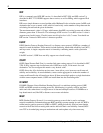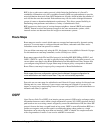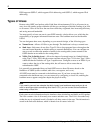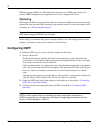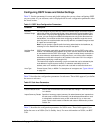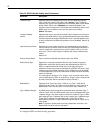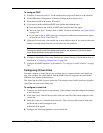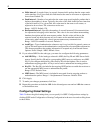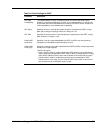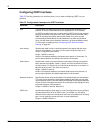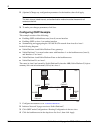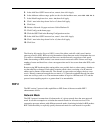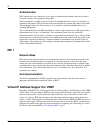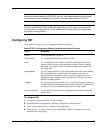
9
360 Nokia Network Voyager for IPSO 4.0 Reference Guide
Hello interval—Length of time, in seconds, between hello packets that the router sends
on the interface. For a given link, this field must be the same on all routers or adjacencies
do not form. Default: 30.
Dead interval—Number of seconds after the router stops receiving hello packets that it
declares the neighbor is down. Typically, the value of this field should be four times that
of the hello interval. For a given link, this value must be the same on all routers, or
adjacencies do not form. The value must not be zero.
Range: 1-65535. Default: 120.
Retransmit interval—Specifies the number of seconds between LSA retransmissions
for adjacencies belonging to this interface. This value is also used when retransmitting
database description and link state request packets. Set this value well above the
expected round-trip delay between any two routers on the attached network. Be
conservative when setting this value to prevent unnecessary retransmissions.
Range: 1-65535 in number of seconds. Default: 5.
Auth Type—Type of authentication scheme to use for a given link. In general, routers on
a given link must agree on the authentication configuration to form neighbor adjacencies.
This feature guarantees that routing information is accepted only from trusted routers.
Options: None / Simple / MD5. Default: None.
5. If you selected MD5 for the auth type, you must also configure the following parameters:
Add MD5 Key— If the Auth type selected is MD5, the Key ID and MD5 Secret fields
appear. Specify the Key ID and its corresponding MD5 secret to configure a new MD5
key. If you configure multiple Key IDs, the Key ID with the highest value is used to
authenticate outgoing packets. All keys can be used to authenticate incoming packets.
Key ID—The Key ID is included in the outgoing OSPF packets to enable the receivers to
use the appropriate MD5 secret to authenticate the packet.
Range: 0-255. Default: None
MD5 Secret—The MD5 secret is included in encrypted form in outgoing packets to
authenticate the packet. Range: 1-16 alphanumeric characters. Default: None
6. Click Apply.
7. To make your changes permanent, click Save.
8. Repeat this procedure on both the ABR for the discontiguous area and an ABR that connects
to the backbone area.
Configuring Global Settings
Table 24 shows the global settings that you can specify for OSPF. Configure these settings by
clicking OSPF under Configuration > Routing Configuration in the tree view and scrolling down
to these fields.



